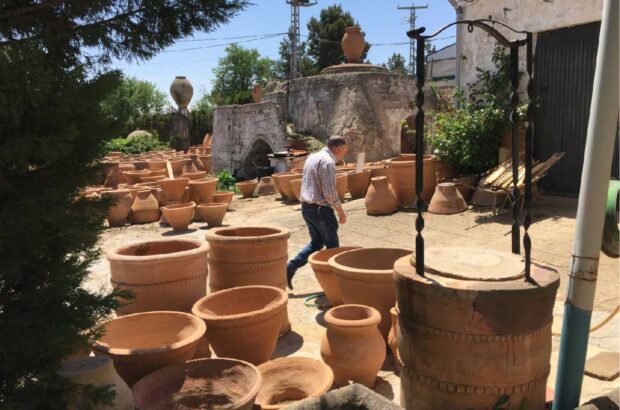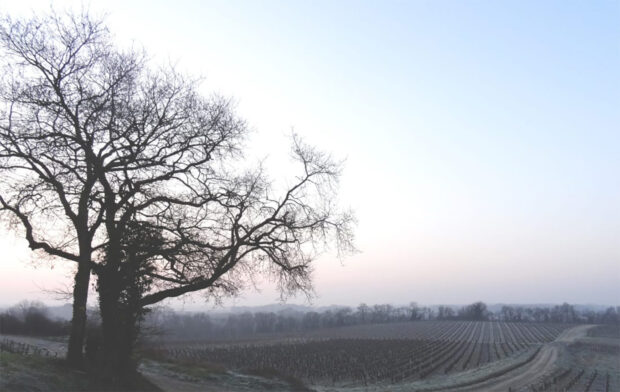Little more than 150 years ago, the Gimblett Gravels Wine Growing District was completely under water. Prior to 1867, the now trademarked, highly sought-after sub-region of Hawke’s Bay was simply the Omahu channel of the Ngaruroro river.
But that year, a flood moved the channel north to the other side of Roy’s Hill, where it flows to this day, leaving an extensive plain of river gravel that can be more than 30m deep.
Too bony and barren to be of much use for farming, the gravel became the sort of wasteland that housed an army rifle range, a landfill site and industrial warehouses. Absolutely no one thought about high-quality wine production.
But in the early 1980s, Chris Pask planted a small block of Cabernet Sauvignon – a variety that struggled to ripen elsewhere in New Zealand. A handful of others soon followed, including soil scientist Alan Limmer, who planted a row of heritage Syrah cuttings he’d rescued from a government research station.
Scroll down for notes and scores for 10 sophisticated wines from Gimblett Gravels
{"content":"PHA+UGFzaywgTGltbWVyIGFuZCBmZWxsb3cgcGlvbmVlcnMgc2F3IHRoZSBwb3RlbnRpYWwgb2YgdGhlIEdyYXZlbHMuIFRoZSB3YXJtdGggb2YgdGhlIHN1biB3YXMgYWJzb3JiZWQgYnkgdGhlIGJyb3duIHJpdmVyIHN0b25lcywgYW5kIHRoZSBsb3ctbHlpbmcgaW5sYW5kIGxvY2F0aW9uIG1lYW50IHRoYXQgd2FybSB0ZW1wZXJhdHVyZXMgYXJyaXZlZCBlYXJsaWVyIGluIHRoZSBkYXkgYW5kIHN0cmV0Y2hlZCBsb25nZXIgaW50byB0aGUgbmlnaHQuPC9wPgo8cD48ZGl2IGNsYXNzPSJhZC1jb250YWluZXIgYWQtY29udGFpbmVyLS1tb2JpbGUiPjxkaXYgaWQ9InBvc3QtaW5saW5lLTIiIGNsYXNzPSJpcGMtYWR2ZXJ0Ij48L2Rpdj48L2Rpdj48L3A+CjxwPlRoaXMgZWxvbmdhdGVkIHRoZSBncm93aW5nIHNlYXNvbiBhbmQgZW5hYmxlZCByaXBlbmluZyBvZiB2YXJpZXRpZXMgdGhhdCBwcmV2aW91c2x5IGhhZCBhbGwgdG9vIG9mdGVuIHByb2R1Y2VkIG1lYW4gYW5kIGdyZWVuIHdpbmVzLjwvcD4KPHA+QWltaW5nIHRvIGhhdmUgdGhlIEdyYXZlbHMgem9uZWQgZm9yIHRoZSBwdXJwb3NlcyBvZiB2aXRpY3VsdHVyZSwgdGhlIHdpbmUtZ3Jvd2VycyB3ZXJlIHNvb24gZW1icm9pbGVkIGluIGEgbGVuZ3RoeSBsZWdhbCBiYXR0bGUgd2l0aCBhIHF1YXJyeSBjb21wYW55IHRoYXQgaGFkIGJvdWdodCAxNTBoYSBvZiB0aGUgbGFuZCwgYnV0IHRoZSBncm93ZXJzIGZpbmFsbHkgcHJldmFpbGVkIG9uIGFwcGVhbCBpbiAxOTkyLjwvcD4KPHA+SnVzdCAyMGhhIHdlcmUgcGxhbnRlZCBhdCB0aGlzIHBvaW50LCBidXQgb3RoZXIgcHJvZHVjZXJzIHdlcmUgdGFraW5nIG5vdGUgb2YgdGhlIHF1YWxpdHkgb2YgdGhlIEJvcmRlYXV4LXN0eWxlIGJsZW5kcyBhbmQgU3lyYWggZW1lcmdpbmcsIGFuZCBwbGFudGluZ3MgZ2F0aGVyZWQgcGFjZS48L3A+CjxkaXYgY2xhc3M9ImFkLWNvbnRhaW5lciBhZC1jb250YWluZXItLW1vYmlsZSI+PGRpdiBpZD0icG9zdC1pbmxpbmUtMyIgY2xhc3M9ImlwYy1hZHZlcnQiPjwvZGl2PjwvZGl2Pgo8aHI+CjxkaXYgaWQ9ImF0dGFjaG1lbnRfNTQzMjI1IiBzdHlsZT0id2lkdGg6IDY0MHB4IiBjbGFzcz0id3AtY2FwdGlvbiBhbGlnbm5vbmUiPjxpbWcgZmV0Y2hwcmlvcml0eT0iaGlnaCIgZGVjb2Rpbmc9ImFzeW5jIiBhcmlhLWRlc2NyaWJlZGJ5PSJjYXB0aW9uLWF0dGFjaG1lbnQtNTQzMjI1IiBjbGFzcz0ibGF6eWxvYWQgYmx1ci11cCBzaXplLWxhcmdlIHdwLWltYWdlLTU0MzIyNSIgZGF0YS1wcm9jZXNzZWQgc3JjPSJodHRwczovL3d3dy5kZWNhbnRlci5jb20vd3AtY29udGVudC90aGVtZXMvc2ltYmEtdGhlbWUvYXNzZXRzL2ltYWdlcy9wbGFjZWhvbGRlci5wbmciIGRhdGEtc3JjPSJodHRwczovL2tleWFzc2V0cy50aW1laW5jdWsubmV0L2luc3BpcmV3cC9saXZlL3dwLWNvbnRlbnQvdXBsb2Fkcy9zaXRlcy8zNC8yMDI0LzExL0dHLU1hcC02MzB4NTA2LmpwZyIgYWx0PSIiIHdpZHRoPSI2MzAiIGhlaWdodD0iNTA2IiBkYXRhLXNpemVzPSJhdXRvIiBkYXRhLXNyY3NldD0iaHR0cHM6Ly9rZXlhc3NldHMudGltZWluY3VrLm5ldC9pbnNwaXJld3AvbGl2ZS93cC1jb250ZW50L3VwbG9hZHMvc2l0ZXMvMzQvMjAyNC8xMS9HRy1NYXAtNjMweDUwNi5qcGcgNjMwdywgaHR0cHM6Ly9rZXlhc3NldHMudGltZWluY3VrLm5ldC9pbnNwaXJld3AvbGl2ZS93cC1jb250ZW50L3VwbG9hZHMvc2l0ZXMvMzQvMjAyNC8xMS9HRy1NYXAtMzAweDI0MS5qcGcgMzAwdywgaHR0cHM6Ly9rZXlhc3NldHMudGltZWluY3VrLm5ldC9pbnNwaXJld3AvbGl2ZS93cC1jb250ZW50L3VwbG9hZHMvc2l0ZXMvMzQvMjAyNC8xMS9HRy1NYXAtMTM1eDEwOS5qcGcgMTM1dywgaHR0cHM6Ly9rZXlhc3NldHMudGltZWluY3VrLm5ldC9pbnNwaXJld3AvbGl2ZS93cC1jb250ZW50L3VwbG9hZHMvc2l0ZXMvMzQvMjAyNC8xMS9HRy1NYXAtMzIweDI1Ny5qcGcgMzIwdywgaHR0cHM6Ly9rZXlhc3NldHMudGltZWluY3VrLm5ldC9pbnNwaXJld3AvbGl2ZS93cC1jb250ZW50L3VwbG9hZHMvc2l0ZXMvMzQvMjAyNC8xMS9HRy1NYXAtNjIweDQ5OC5qcGcgNjIwdywgaHR0cHM6Ly9rZXlhc3NldHMudGltZWluY3VrLm5ldC9pbnNwaXJld3AvbGl2ZS93cC1jb250ZW50L3VwbG9hZHMvc2l0ZXMvMzQvMjAyNC8xMS9HRy1NYXAuanBnIDgwMHciIHNpemVzPSIobWF4LXdpZHRoOiA2MzBweCkgMTAwdncsIDYzMHB4IiAvPjxwIGlkPSJjYXB0aW9uLWF0dGFjaG1lbnQtNTQzMjI1IiBjbGFzcz0id3AtY2FwdGlvbi10ZXh0Ij5DcmVkaXQ6IEpQIE1hcCBHcmFwaGljcyBMdGQuPC9wPjwvZGl2Pgo8aHI+CjxoMj5DbGltYXRlIGNyZWRlbnRpYWxzPC9oMj4KPHA+SGF3a2XigJlzIEJheSBpcyBvbmUgb2YgTmV3IFplYWxhbmTigJlzIHdhcm1lciB3aW5lIHJlZ2lvbnMsIHRob3VnaCB0aGF04oCZcyB2ZXJ5IG11Y2ggd2l0aGluIGEgY29vbC1jbGltYXRlIGNvbnRleHQg4oCTIGl0cyBtb2RlcmF0ZSwgbWFyaXRpbWUtaW5mbHVlbmNlZCBjbGltYXRlIGlzIGFraW4gdG8gdGhhdCBvZiA8c3Ryb25nPjxhIGhyZWY9Imh0dHBzOi8vd3d3LmRlY2FudGVyLmNvbS93aW5lL3dpbmUtcmVnaW9ucy9ib3JkZWF1eC13aW5lcy8iIHRhcmdldD0iX2JsYW5rIiByZWw9Im5vb3BlbmVyIj5Cb3JkZWF1eDwvYT48L3N0cm9uZz4uIFN1bnNoaW5lIGhvdXJzIGFyZSBoaWdoLCBidXQgdGVtcGVyaW5nIHNlYSBicmVlemVzIGVuc3VyZSBkYXlzIGFib3ZlIDMwwrBDIGFyZSByZWxhdGl2ZWx5IHJhcmUuPC9wPgo8ZGl2IGNsYXNzPSJhZC1jb250YWluZXIgYWQtY29udGFpbmVyLS1tb2JpbGUiPjxkaXYgaWQ9InBvc3QtaW5saW5lLTQiIGNsYXNzPSJpcGMtYWR2ZXJ0Ij48L2Rpdj48L2Rpdj4KPHA+R2ltYmxldHQgR3JhdmVscyBpc27igJl0IHRoZSBvbmx5IHN1Yi1yZWdpb24gb2YgSGF3a2XigJlzIEJheSB0byBwcm9kdWNlIHF1YWxpdHkgcmVkcyDigJMgSGF2ZWxvY2sgSGlsbHMgYW5kIEJyaWRnZSBQYSBUcmlhbmdsZSBib3RoIGhhdmUgcGVkaWdyZWUgaW4gdGhhdCByZWdhcmQg4oCTIGJ1dCBpdHMgdW5pcXVlbmVzcyByZXNpZGVzIGluIGl0cyBjb21iaW5hdGlvbiBvZiBzb2lscyBhbmQgY2xpbWF0ZS48L3A+CjxwPkF0IGFib3V0IDE1a20gaW5sYW5kIGFuZCAzMG0gYWJvdmUgc2VhIGxldmVsLCB0aGUgcmVkdWNlZCBtYXJpdGltZSBpbmZsdWVuY2UgYW5kIHRoZSBpbXBhY3Qgb2YgUm954oCZcyBIaWxsIHNoZWx0ZXJpbmcgaXQgZnJvbSBjb29sZXIgc291dGh3ZXN0ZXJseSB3aW5kcyBjb21iaW5lIHRvIGFkZCBhIGZldyBkZWdyZWVzIHRvIHRoZSBtYXhpbXVtIGRheXRpbWUgdGVtcGVyYXR1cmVzLjwvcD4KPGRpdiBjbGFzcz0iYWQtY29udGFpbmVyIGFkLWNvbnRhaW5lci0tbW9iaWxlIj48ZGl2IGlkPSJwb3N0LWlubGluZS01IiBjbGFzcz0iaXBjLWFkdmVydCI+PC9kaXY+PC9kaXY+CjxwPlRoaXMgd2FybXRoIGFuZCBzdW5zaGluZSwgYWxpZ25lZCB3aXRoIHRoZSB2ZXJ5IHN0b255LCB2ZXJ5IGZyZWUtZHJhaW5pbmcgc29pbHMgKGlycmlnYXRpb24gaXMgZXNzZW50aWFsIGhlcmUpLCBjcmVhdGUgd2hhdCBsb25ndGltZSBHcmF2ZWxzIHZpZ25lcm9uIFN0ZXZlIFNtaXRoIE1XIG9mIFNtaXRoICZhbXA7IFNoZXRoIGNhbGxzIGEg4oCYdGhlcm1hbCBibGFua2V0IGZvciB0aGUgdmluZXPigJkuPC9wPgo8cD5DaHVyY2ggUm9hZCB3aW5lbWFrZXIgQ2hyaXMgU2NvdHQgY29uY3Vycywgb2JzZXJ2aW5nOiDigJhJbiBhbiB1bnByZWRpY3RhYmxlIFJvYXJpbmcgRm9ydGllcyBpc2xhbmQgY2xpbWF0ZSwgdGhlIHZlcnkgbG93IHdhdGVyLWhvbGRpbmcgY2FwYWNpdHkgb2YgdGhvc2UgZ3JhdmVscyBpcyBhIGdyZWF0IGxldmVsbGVyIGluIHdldHRlciBzZWFzb25zIOKAkyBub3QganVzdCBpbiB0ZXJtcyBvZiByZWR1Y2luZyBkaWx1dGlvbiwgYnV0IHdpdGggbGVzcyBodW1pZGl0eSwgY2Fub3B5IGRlbnNpdHkgYW5kIHZpbmV5YXJkLWZsb29yIGdyb3d0aCwgZXZlcnl0aGluZyBkcmllcyBvdXQgZmFzdGVyLiBUaGVyZeKAmXMgbGVzcyBkaXNlYXNlIHByZXNzdXJlIGFuZCBtb3JlIGNoYW5jZSBvZiBhY2hpZXZpbmcgb3B0aW1hbCByaXBlbmVzcywgd2hpY2ggaXMgZnVydGhlciBlbmhhbmNlZCBieSB0aGUgc29pbHMgcmV0YWluaW5nIHRoZSBkYXnigJlzIGhlYXQgZm9yIGxvbmdlciBhdCBuaWdodC7igJk8L3A+CjxwPlRoZSBhcm9tYXRpYyBmcmVzaG5lc3Mgb2YgR2ltYmxldHQgR3JhdmVscyB3aW5lcywgYWxsaWVkIHdpdGggdGhlaXIgZ3JlYXQgY29uY2VudHJhdGlvbiBhbmQgZmluZXNzZSwgaXMgYSBzb3VnaHQtYWZ0ZXIgY29tYmluYXRpb246IHRoZSBwcm92ZXJiaWFsIOKAmGlyb24gZmlzdCBpbiBhIHZlbHZldCBnbG92ZeKAmSwgYXMgU21pdGggZGVzY3JpYmVzIGl0LjwvcD4KPGRpdiBpZD0iYXR0YWNobWVudF81NDMyMzIiIHN0eWxlPSJ3aWR0aDogNjEwcHgiIGNsYXNzPSJ3cC1jYXB0aW9uIGFsaWdubm9uZSI+PGltZyBkZWNvZGluZz0iYXN5bmMiIGFyaWEtZGVzY3JpYmVkYnk9ImNhcHRpb24tYXR0YWNobWVudC01NDMyMzIiIGNsYXNzPSJsYXp5bG9hZCBibHVyLXVwIHdwLWltYWdlLTU0MzIzMiBzaXplLWZ1bGwiIGRhdGEtcHJvY2Vzc2VkIHNyYz0iaHR0cHM6Ly93d3cuZGVjYW50ZXIuY29tL3dwLWNvbnRlbnQvdGhlbWVzL3NpbWJhLXRoZW1lL2Fzc2V0cy9pbWFnZXMvcGxhY2Vob2xkZXIucG5nIiBkYXRhLXNyYz0iaHR0cHM6Ly9rZXlhc3NldHMudGltZWluY3VrLm5ldC9pbnNwaXJld3AvbGl2ZS93cC1jb250ZW50L3VwbG9hZHMvc2l0ZXMvMzQvMjAyNC8xMS9UaGUtZGlzdGluY3RpdmVseS1wZWJibHktZ3JvdW5kLW9mLUdpbWJsZXR0LUdyYXZlbHMtV2luZS1Hcm93aW5nLURpc3RyaWN0Li1DcmVkaXQtR0dXQS5qcGciIGFsdD0iIiB3aWR0aD0iNjAwIiBoZWlnaHQ9IjQwMCIgZGF0YS1zaXplcz0iYXV0byIgZGF0YS1zcmNzZXQ9Imh0dHBzOi8va2V5YXNzZXRzLnRpbWVpbmN1ay5uZXQvaW5zcGlyZXdwL2xpdmUvd3AtY29udGVudC91cGxvYWRzL3NpdGVzLzM0LzIwMjQvMTEvVGhlLWRpc3RpbmN0aXZlbHktcGViYmx5LWdyb3VuZC1vZi1HaW1ibGV0dC1HcmF2ZWxzLVdpbmUtR3Jvd2luZy1EaXN0cmljdC4tQ3JlZGl0LUdHV0EuanBnIDYwMHcsIGh0dHBzOi8va2V5YXNzZXRzLnRpbWVpbmN1ay5uZXQvaW5zcGlyZXdwL2xpdmUvd3AtY29udGVudC91cGxvYWRzL3NpdGVzLzM0LzIwMjQvMTEvVGhlLWRpc3RpbmN0aXZlbHktcGViYmx5LWdyb3VuZC1vZi1HaW1ibGV0dC1HcmF2ZWxzLVdpbmUtR3Jvd2luZy1EaXN0cmljdC4tQ3JlZGl0LUdHV0EtMzAweDIwMC5qcGcgMzAwdywgaHR0cHM6Ly9rZXlhc3NldHMudGltZWluY3VrLm5ldC9pbnNwaXJld3AvbGl2ZS93cC1jb250ZW50L3VwbG9hZHMvc2l0ZXMvMzQvMjAyNC8xMS9UaGUtZGlzdGluY3RpdmVseS1wZWJibHktZ3JvdW5kLW9mLUdpbWJsZXR0LUdyYXZlbHMtV2luZS1Hcm93aW5nLURpc3RyaWN0Li1DcmVkaXQtR0dXQS0xMzV4OTAuanBnIDEzNXcsIGh0dHBzOi8va2V5YXNzZXRzLnRpbWVpbmN1ay5uZXQvaW5zcGlyZXdwL2xpdmUvd3AtY29udGVudC91cGxvYWRzL3NpdGVzLzM0LzIwMjQvMTEvVGhlLWRpc3RpbmN0aXZlbHktcGViYmx5LWdyb3VuZC1vZi1HaW1ibGV0dC1HcmF2ZWxzLVdpbmUtR3Jvd2luZy1EaXN0cmljdC4tQ3JlZGl0LUdHV0EtMzIweDIxMy5qcGcgMzIwdyIgc2l6ZXM9IihtYXgtd2lkdGg6IDYwMHB4KSAxMDB2dywgNjAwcHgiIC8+PHAgaWQ9ImNhcHRpb24tYXR0YWNobWVudC01NDMyMzIiIGNsYXNzPSJ3cC1jYXB0aW9uLXRleHQiPlRoZSBkaXN0aW5jdGl2ZWx5IHBlYmJseSBncm91bmQgb2YgR2ltYmxldHQgR3JhdmVscyBXaW5lIEdyb3dpbmcgRGlzdHJpY3QuIENyZWRpdDogR0dXQS48L3A+PC9kaXY+Cjxocj4KPGRpdiBjbGFzcz0iYnJlYWtvdXQgcGFsZXR0ZS1hIHBhbmVsIHBhbmVsLWRlZmF1bHQiPjxkaXYgY2xhc3M9InBhbmVsLWJvZHkiPjxkaXYgY2xhc3M9J2JyZWFrb3V0LWNvbnRlbnQnPjwvcD4KPGgyIHN0eWxlPSJ0ZXh0LWFsaWduOiBjZW50ZXIiPkdpbWJsZXR0IEdyYXZlbHMgYXQgYSBnbGFuY2U8L2gyPgo8cCBzdHlsZT0idGV4dC1hbGlnbjogY2VudGVyIj48c3Ryb25nPkZpcnN0IHBsYW50ZWQ6PC9zdHJvbmc+IDE5ODE8YnIgLz4KPHN0cm9uZz5BcmVhIHVuZGVyIHZpbmU6PC9zdHJvbmc+IDgwMGhhPGJyIC8+CjxzdHJvbmc+U29pbHM6PC9zdHJvbmc+IERlZXAgcml2ZXIgZ3JhdmVscyB3aXRoIHNhbmR5IHBvY2tldHMsIGdldHRpbmcgc2lsdGllciB3aXRoIGluY3JlYXNpbmcgcHJveGltaXR5IHRvIHRoZSBwcmVzZW50LWRheSByaXZlciBjb3Vyc2U8YnIgLz4KPHN0cm9uZz5SZWQgZ3JhcGVzICg5MCUpOjwvc3Ryb25nPiAzNSUgPHN0cm9uZz48YSBocmVmPSJodHRwczovL3d3dy5kZWNhbnRlci5jb20vd2luZS9ncmFwZS12YXJpZXRpZXMvbWVybG90LyIgdGFyZ2V0PSJfYmxhbmsiIHJlbD0ibm9vcGVuZXIiPk1lcmxvdDwvYT48L3N0cm9uZz4sIDIwJSBTeXJhaCwgMTUlIENhYmVybmV0IFNhdXZpZ25vbiwgNyUgPHN0cm9uZz48YSBocmVmPSJodHRwczovL3d3dy5kZWNhbnRlci5jb20vd2luZS9ncmFwZS12YXJpZXRpZXMvbWFsYmVjLyIgdGFyZ2V0PSJfYmxhbmsiIHJlbD0ibm9vcGVuZXIiPk1hbGJlYzwvYT48L3N0cm9uZz4sIDQlIDxzdHJvbmc+PGEgaHJlZj0iaHR0cHM6Ly93d3cuZGVjYW50ZXIuY29tL3dpbmUvZ3JhcGUtdmFyaWV0aWVzL2NhYmVybmV0LWZyYW5jLyIgdGFyZ2V0PSJfYmxhbmsiIHJlbD0ibm9vcGVuZXIiPkNhYmVybmV0IEZyYW5jPC9hPjwvc3Ryb25nPiwgcGx1cyA8c3Ryb25nPjxhIGhyZWY9Imh0dHBzOi8vd3d3LmRlY2FudGVyLmNvbS93aW5lL2dyYXBlLXZhcmlldGllcy9ncmVuYWNoZS1nYXJuYWNoYS8iIHRhcmdldD0iX2JsYW5rIiByZWw9Im5vb3BlbmVyIj5HcmVuYWNoZTwvYT48L3N0cm9uZz4sIDxzdHJvbmc+PGEgaHJlZj0iaHR0cHM6Ly93d3cuZGVjYW50ZXIuY29tL3dpbmUvZ3JhcGUtdmFyaWV0aWVzL21vbnRlcHVsY2lhbm8vIiB0YXJnZXQ9Il9ibGFuayIgcmVsPSJub29wZW5lciI+TW9udGVwdWxjaWFubzwvYT4gPC9zdHJvbmc+YW5kIDxzdHJvbmc+PGEgaHJlZj0iaHR0cHM6Ly93d3cuZGVjYW50ZXIuY29tL3dpbmUvZ3JhcGUtdmFyaWV0aWVzL3RlbXByYW5pbGxvLXRpbnRvLWZpbm8vIiB0YXJnZXQ9Il9ibGFuayIgcmVsPSJub29wZW5lciI+VGVtcHJhbmlsbG88L2E+IDwvc3Ryb25nPmFtb25nIG90aGVyczxiciAvPgo8c3Ryb25nPldoaXRlIGdyYXBlcyAoMTAlKTo8L3N0cm9uZz4gTW9zdGx5IDxzdHJvbmc+PGEgaHJlZj0iaHR0cHM6Ly93d3cuZGVjYW50ZXIuY29tL3dpbmUvZ3JhcGUtdmFyaWV0aWVzL2NoYXJkb25uYXkvIiB0YXJnZXQ9Il9ibGFuayIgcmVsPSJub29wZW5lciI+Q2hhcmRvbm5heTwvYT48L3N0cm9uZz4sIHRoZW4gPGEgaHJlZj0iaHR0cHM6Ly93d3cuZGVjYW50ZXIuY29tL3dpbmUvZ3JhcGUtdmFyaWV0aWVzL3Zpb2duaWVyLyIgdGFyZ2V0PSJfYmxhbmsiIHJlbD0ibm9vcGVuZXIiPjxzdHJvbmc+VmlvZ25pZXI8L3N0cm9uZz48L2E+LCBwbHVzIEFybmVpcywgPGEgaHJlZj0iaHR0cHM6Ly93d3cuZGVjYW50ZXIuY29tL3dpbmUvZ3JhcGUtdmFyaWV0aWVzL0dld3VyenRyYW1pbmVyLyIgdGFyZ2V0PSJfYmxhbmsiIHJlbD0ibm9vcGVuZXIiPjxzdHJvbmc+R2V3dXJ6dHJhbWluZXI8L3N0cm9uZz48L2E+LCA8c3Ryb25nPjxhIGhyZWY9Imh0dHBzOi8vd3d3LmRlY2FudGVyLmNvbS93aW5lL2dyYXBlLXZhcmlldGllcy9tYXJzYW5uZS8iIHRhcmdldD0iX2JsYW5rIiByZWw9Im5vb3BlbmVyIj5NYXJzYW5uZTwvYT48L3N0cm9uZz4sIDxhIGhyZWY9Imh0dHBzOi8vd3d3LmRlY2FudGVyLmNvbS93aW5lL2dyYXBlLXZhcmlldGllcy9yb3Vzc2FubmUvIiB0YXJnZXQ9Il9ibGFuayIgcmVsPSJub29wZW5lciI+PHN0cm9uZz5Sb3Vzc2FubmU8L3N0cm9uZz4gPC9hPmFuZCA8YSBocmVmPSJodHRwczovL3d3dy5kZWNhbnRlci5jb20vd2luZS9ncmFwZS12YXJpZXRpZXMvcmllc2xpbmcvIiB0YXJnZXQ9Il9ibGFuayIgcmVsPSJub29wZW5lciI+PHN0cm9uZz5SaWVzbGluZzwvc3Ryb25nPjwvYT48YnIgLz4KPHN0cm9uZz5HZW5lcmljIGJvZHk6PC9zdHJvbmc+IFRoZSA8YSBocmVmPSJodHRwczovL3RoZWdpbWJsZXR0Z3JhdmVscy5jb20vIiB0YXJnZXQ9Il9ibGFuayIgcmVsPSJub2ZvbGxvdyBub29wZW5lciI+PHN0cm9uZz5HaW1ibGV0dCBHcmF2ZWxzIFdpbmVncm93ZXJzIEFzc29jaWF0aW9uPC9zdHJvbmc+PC9hPiB3YXMgZm9ybWVkIGluIDIwMDEgYW5kIGhhcyAyNCBtZW1iZXJzPC9wPgo8cD4KPC9kaXY+PGRpdiBjbGFzcz0nYnJlYWtvdXQtYnV0dG9ucyc+PGRpdiBjbGFzcz0ncm93Jz48L2Rpdj48L2Rpdj48L2Rpdj48L2Rpdj4KPGhyPgo8aDI+VHJhZGVtYXJrIHByb3RlY3Rpb248L2gyPgo8cD5HaW1ibGV0dCBHcmF2ZWxzIGdyb3dlcnMgc29vbiByZWFsaXNlZCB0aGF0IHRoZWlyIGFyZWEgbmVlZGVkIGJvdGggcHJvdGVjdGlvbiBhbmQgcHJvbW90aW9uLiBJbiAyMDAxLCB0aGV5IGNhbWUgdG9nZXRoZXIgYXMgdGhlIEdpbWJsZXR0IEdyYXZlbHMgV2luZWdyb3dlcnMgQXNzb2NpYXRpb24gKEdHV0EpIGFuZCB0cmFkZW1hcmtlZCB0aGUgR2ltYmxldHQgR3JhdmVscyBXaW5lIEdyb3dpbmcgRGlzdHJpY3QuPC9wPgo8cD5BdCB0aGF0IHRpbWUsIE5ldyBaZWFsYW5k4oCZcyBHZW9ncmFwaGljYWwgSW5kaWNhdGlvbnMgUmVnaXN0cmF0aW9uIEFjdCB3YXMgaW4gZGV2ZWxvcG1lbnQsIGFuZCBpdHMgZGVsaW5lYXRpb25zIHdlcmUgYmFzZWQgdXBvbiBnZW9wb2xpdGljYWwgYm91bmRhcmllcyBhbmQgcGh5c2ljYWwgYXR0cmlidXRlcyBzdWNoIGFzIHJvYWRzIG9yIHJpdmVycywgbm90IHNvaWwgdHlwZXMuPC9wPgo8cD5JbnRlcm5hdGlvbmFsIHRyYWRlbWFyayBsYXcgd2FzIHZpZXdlZCBhcyBiZXN0b3dpbmcgZ3JlYXRlciBwcm90ZWN0aW9uLCB3aGlsZSBhbHNvIGFsbG93aW5nIHRoZSBHR1dBIHRvIHNldCBzdHJpY3RlciBydWxlcy4gV2luZXMgYmVhcmluZyB0aGUgR2ltYmxldHQgR3JhdmVscyBuYW1lIGFuZC9vciBsb2dvIG11c3QgaGF2ZSA5NSUgb2YgdGhlaXIgZnJ1aXQgZnJvbSB0aGUgZGlzdHJpY3QsIGNvbXBhcmVkIHdpdGggYSBHSeKAmXMgODUlLjwvcD4KPHA+TWVtYmVycyBtdXN0IG93biBhIHZpbmV5YXJkIGluIHRoZSBkaXN0cmljdCBhbmQgdmluZXlhcmRzIG11c3QgaGF2ZSA5NSUgb2YgdGhlaXIgc29pbHMgY2xhc3NpZmllZCBhcyBvbmUgb2YgdGhyZWUgb2ZmaWNpYWwgc29pbCB0eXBlcy48L3A+CjxwPlRoZSBkaXN0cmljdCBoYXMgc2luY2UgYmVlbiBkZXNpZ25hdGVkIGEg4oCYc3BlY2lhbCBjaGFyYWN0ZXIgem9uZeKAmSBieSB0aGUgbG9jYWwgY291bmNpbCwgd2hpY2ggd291bGQgYWxsb3cgaXQgdG8gYmVjb21lIGEgR0kgaW4gZHVlIGNvdXJzZSwgYnV0IHRoZSBtZW1iZXJzIGFyZSByZWx1Y3RhbnQgdG8gYWJhbmRvbiB0aGVpciBzdHJpY3RlciBwcm92ZW5hbmNlIHJ1bGVzLjwvcD4KPHA+VGhlIDI0IG1lbWJlcnMgcHJvbW90ZSBvbmUgYW5vdGhlcuKAmXMgd2luZXMgaW4gdGhlIG1hcmtldCwgcGFydGljaXBhdGUgaW4gYW4gaW5kZXBlbmRlbnRseSBzZWxlY3RlZCBBbm51YWwgVmludGFnZSBTZWxlY3Rpb24gdGhhdOKAmXMgc2VudCBvdXQgdG8gZ2xvYmFsIGluZmx1ZW5jZXJzLCBhbmQgdGhleSBiZW5lZml0IGZyb20gYSB0ZWNobmljYWwgY29tbWl0dGVlIGFpbWVkIGF0IGVuaGFuY2luZyB3aW5lIHF1YWxpdHkuPC9wPgo8aHI+CjxkaXYgY2xhc3M9ImJyZWFrb3V0IHBhbGV0dGUtYSBwYW5lbCBwYW5lbC1kZWZhdWx0Ij48ZGl2IGNsYXNzPSJwYW5lbC1ib2R5Ij48ZGl2IGNsYXNzPSdicmVha291dC1jb250ZW50Jz48L3A+CjxoMj5FaWdodCBHaW1ibGV0dCBHcmF2ZWxzIHByb2R1Y2VycyB0byBrbm93PC9oMj4KPGgzPkJsYW5rIENhbnZhczwvaDM+CjxwPkEgcGFydG5lcnNoaXAgaW4gd2luZSBhbmQgbGlmZSwgQmxhbmsgQ2FudmFzIGlzIHRoZSBsYWJlbCBhbmQg4oCYdmlub3VzIHN0dWRpb+KAmSBvZiBmb3JtZXIgU2FpbnQgQ2xhaXIgd2luZW1ha2VyIE1hdHQgVGhvbXNvbiBhbmQgaGlzIHdpZmUgU29waGllIFBhcmtlci1UaG9tc29uIE1XLCB3aG8gc291cmNlIGdyYXBlcyBmcm9tIHJlbm93bmVkIHNpdGVzIGFsbCBvdmVyIE5ldyBaZWFsYW5kLCBtYWtpbmcgc3R5bGlzaCwgZXhwcmVzc2l2ZSBzaW5nbGUtdmluZXlhcmQgd2luZXMuPC9wPgo8cD5TaW5jZSAyMDE3LCB0aGV54oCZdmUgbWFkZSBTeXJhaCBmcm9tIHRoZSAyLjRoYSBFbGVtZW50IHZpbmV5YXJkLCB0aGUgR2ltYmxldHQgR3JhdmVsc+KAmSBzbWFsbGVzdCwgd2hpY2ggdGhleSBzb21ldGltZXMgY28tZmVybWVudCB3aXRoIDxzdHJvbmc+PGEgaHJlZj0iaHR0cHM6Ly93d3cuZGVjYW50ZXIuY29tL3dpbmUvZ3JhcGUtdmFyaWV0aWVzL2dydW5lci12ZWx0bGluZXItZ3JhcGUtdmFyaWV0aWVzLyIgdGFyZ2V0PSJfYmxhbmsiIHJlbD0ibm9vcGVuZXIiPkdyw7xuZXIgVmVsdGxpbmVyPC9hPjwvc3Ryb25nPiBza2lucyB0byBlbmhhbmNlIHRoZSB3aGl0ZSBwZXBwZXIgY2hhcmFjdGVyaXN0aWNzLjwvcD4KPHA+PGEgaHJlZj0iaHR0cHM6Ly9ibGFua2NhbnZhc3dpbmVzLmNvbS8iIHRhcmdldD0iX2JsYW5rIiByZWw9Im5vZm9sbG93IG5vb3BlbmVyIj48c3Ryb25nPmJsYW5rY2FudmFzd2luZXMuY29tPC9zdHJvbmc+PC9hPjwvcD4KPHA+PGRpdiBpZD0iYXR0YWNobWVudF81NDMyMjciIHN0eWxlPSJ3aWR0aDogNjEwcHgiIGNsYXNzPSJ3cC1jYXB0aW9uIGFsaWdubm9uZSI+PGltZyBkZWNvZGluZz0iYXN5bmMiIGFyaWEtZGVzY3JpYmVkYnk9ImNhcHRpb24tYXR0YWNobWVudC01NDMyMjciIGNsYXNzPSJsYXp5bG9hZCBibHVyLXVwIHNpemUtZnVsbCB3cC1pbWFnZS01NDMyMjciIGRhdGEtcHJvY2Vzc2VkIHNyYz0iaHR0cHM6Ly93d3cuZGVjYW50ZXIuY29tL3dwLWNvbnRlbnQvdGhlbWVzL3NpbWJhLXRoZW1lL2Fzc2V0cy9pbWFnZXMvcGxhY2Vob2xkZXIucG5nIiBkYXRhLXNyYz0iaHR0cHM6Ly9rZXlhc3NldHMudGltZWluY3VrLm5ldC9pbnNwaXJld3AvbGl2ZS93cC1jb250ZW50L3VwbG9hZHMvc2l0ZXMvMzQvMjAyNC8xMS9NYXR0LVRob21zb24tYW5kLWhpcy13aWZlLVNvcGhpZS1QYXJrZXItVGhvbXNvbi1NVy4tQ3JlZGl0LUZyYW5jaW5lLUJvZXItUGhvdG9ncmFwaHkuanBnIiBhbHQ9IiIgd2lkdGg9IjYwMCIgaGVpZ2h0PSI0MDAiIGRhdGEtc2l6ZXM9ImF1dG8iIGRhdGEtc3Jjc2V0PSJodHRwczovL2tleWFzc2V0cy50aW1laW5jdWsubmV0L2luc3BpcmV3cC9saXZlL3dwLWNvbnRlbnQvdXBsb2Fkcy9zaXRlcy8zNC8yMDI0LzExL01hdHQtVGhvbXNvbi1hbmQtaGlzLXdpZmUtU29waGllLVBhcmtlci1UaG9tc29uLU1XLi1DcmVkaXQtRnJhbmNpbmUtQm9lci1QaG90b2dyYXBoeS5qcGcgNjAwdywgaHR0cHM6Ly9rZXlhc3NldHMudGltZWluY3VrLm5ldC9pbnNwaXJld3AvbGl2ZS93cC1jb250ZW50L3VwbG9hZHMvc2l0ZXMvMzQvMjAyNC8xMS9NYXR0LVRob21zb24tYW5kLWhpcy13aWZlLVNvcGhpZS1QYXJrZXItVGhvbXNvbi1NVy4tQ3JlZGl0LUZyYW5jaW5lLUJvZXItUGhvdG9ncmFwaHktMzAweDIwMC5qcGcgMzAwdywgaHR0cHM6Ly9rZXlhc3NldHMudGltZWluY3VrLm5ldC9pbnNwaXJld3AvbGl2ZS93cC1jb250ZW50L3VwbG9hZHMvc2l0ZXMvMzQvMjAyNC8xMS9NYXR0LVRob21zb24tYW5kLWhpcy13aWZlLVNvcGhpZS1QYXJrZXItVGhvbXNvbi1NVy4tQ3JlZGl0LUZyYW5jaW5lLUJvZXItUGhvdG9ncmFwaHktMTM1eDkwLmpwZyAxMzV3LCBodHRwczovL2tleWFzc2V0cy50aW1laW5jdWsubmV0L2luc3BpcmV3cC9saXZlL3dwLWNvbnRlbnQvdXBsb2Fkcy9zaXRlcy8zNC8yMDI0LzExL01hdHQtVGhvbXNvbi1hbmQtaGlzLXdpZmUtU29waGllLVBhcmtlci1UaG9tc29uLU1XLi1DcmVkaXQtRnJhbmNpbmUtQm9lci1QaG90b2dyYXBoeS0zMjB4MjEzLmpwZyAzMjB3IiBzaXplcz0iKG1heC13aWR0aDogNjAwcHgpIDEwMHZ3LCA2MDBweCIgLz48L3A+CjxwIGlkPSJjYXB0aW9uLWF0dGFjaG1lbnQtNTQzMjI3IiBjbGFzcz0id3AtY2FwdGlvbi10ZXh0Ij5NYXR0IFRob21zb24gYW5kIGhpcyB3aWZlIFNvcGhpZSBQYXJrZXItVGhvbXNvbiBNVy4gQ3JlZGl0OiBGcmFuY2luZSBCb2VyIFBob3RvZ3JhcGh5LjwvcD4KPC9kaXY+Cjxocj4KPGgzPkNoYXRlYXUgR2FyYWdlPC9oMz4KPHA+Rm9ybWVyIFZpbGxhIE1hcmlhIGNoaWVmIHZpdGljdWx0dXJpc3QgT2xsaWUgUG93cmll4oCZcyBvd24gbGFiZWwsIG1hZGUgKG9idmlvdXNseSkgaW4gaGlzIChwcmV0dHktc3R5bGlzaCkgZ2FyYWdlLCB0aGlzIGlzIGEgdGlueSBsYWJlbCB0aGF0IHRha2VzIGl0cyB3aW5lcyBzZXJpb3VzbHkgd2hpbGUgbm90IHRha2luZyBpdHNlbGYgc2VyaW91c2x5LjwvcD4KPHA+UG93cmllIHNvdXJjZXMgQ2FiZXJuZXQgU2F1dmlnbm9uIGZyb20gdGhlIENvcm5lcnN0b25lIHZpbmV5YXJkIGFuZCB1c2VzIGl0IHRvIG1ha2UgdGhyZWUgdmVyeSBkaWZmZXJlbnQgc3R5bGVzLCBpbmNsdWRpbmcgdGhlIGZsYWdzaGlwIEh1Z28sIG5hbWVkIGZvciBoaXMgYnJvdGhlci48L3A+CjxwPjxhIGhyZWY9Imh0dHBzOi8vd3d3LmNoYXRlYXVnYXJhZ2UuY28ubnovIiB0YXJnZXQ9Il9ibGFuayIgcmVsPSJub2ZvbGxvdyBub29wZW5lciI+PHN0cm9uZz5jaGF0ZWF1Z2FyYWdlLmNvLm56PC9zdHJvbmc+PC9hPjwvcD4KPHA+PGRpdiBpZD0iYXR0YWNobWVudF81NDMyMjgiIHN0eWxlPSJ3aWR0aDogNjEwcHgiIGNsYXNzPSJ3cC1jYXB0aW9uIGFsaWdubm9uZSI+PGltZyBsb2FkaW5nPSJsYXp5IiBkZWNvZGluZz0iYXN5bmMiIGFyaWEtZGVzY3JpYmVkYnk9ImNhcHRpb24tYXR0YWNobWVudC01NDMyMjgiIGNsYXNzPSJsYXp5bG9hZCBibHVyLXVwIHNpemUtZnVsbCB3cC1pbWFnZS01NDMyMjgiIGRhdGEtcHJvY2Vzc2VkIHNyYz0iaHR0cHM6Ly93d3cuZGVjYW50ZXIuY29tL3dwLWNvbnRlbnQvdGhlbWVzL3NpbWJhLXRoZW1lL2Fzc2V0cy9pbWFnZXMvcGxhY2Vob2xkZXIucG5nIiBkYXRhLXNyYz0iaHR0cHM6Ly9rZXlhc3NldHMudGltZWluY3VrLm5ldC9pbnNwaXJld3AvbGl2ZS93cC1jb250ZW50L3VwbG9hZHMvc2l0ZXMvMzQvMjAyNC8xMS9PbGxpZS1Qb3dyaWUtQ2hhdGVhdS1HYXJhZ2UuLUNyZWRpdC1SaWNoYXJkLUJyaW1lci5qcGciIGFsdD0iIiB3aWR0aD0iNjAwIiBoZWlnaHQ9IjQwMCIgZGF0YS1zaXplcz0iYXV0byIgZGF0YS1zcmNzZXQ9Imh0dHBzOi8va2V5YXNzZXRzLnRpbWVpbmN1ay5uZXQvaW5zcGlyZXdwL2xpdmUvd3AtY29udGVudC91cGxvYWRzL3NpdGVzLzM0LzIwMjQvMTEvT2xsaWUtUG93cmllLUNoYXRlYXUtR2FyYWdlLi1DcmVkaXQtUmljaGFyZC1CcmltZXIuanBnIDYwMHcsIGh0dHBzOi8va2V5YXNzZXRzLnRpbWVpbmN1ay5uZXQvaW5zcGlyZXdwL2xpdmUvd3AtY29udGVudC91cGxvYWRzL3NpdGVzLzM0LzIwMjQvMTEvT2xsaWUtUG93cmllLUNoYXRlYXUtR2FyYWdlLi1DcmVkaXQtUmljaGFyZC1CcmltZXItMzAweDIwMC5qcGcgMzAwdywgaHR0cHM6Ly9rZXlhc3NldHMudGltZWluY3VrLm5ldC9pbnNwaXJld3AvbGl2ZS93cC1jb250ZW50L3VwbG9hZHMvc2l0ZXMvMzQvMjAyNC8xMS9PbGxpZS1Qb3dyaWUtQ2hhdGVhdS1HYXJhZ2UuLUNyZWRpdC1SaWNoYXJkLUJyaW1lci0xMzV4OTAuanBnIDEzNXcsIGh0dHBzOi8va2V5YXNzZXRzLnRpbWVpbmN1ay5uZXQvaW5zcGlyZXdwL2xpdmUvd3AtY29udGVudC91cGxvYWRzL3NpdGVzLzM0LzIwMjQvMTEvT2xsaWUtUG93cmllLUNoYXRlYXUtR2FyYWdlLi1DcmVkaXQtUmljaGFyZC1CcmltZXItMzIweDIxMy5qcGcgMzIwdyIgc2l6ZXM9IihtYXgtd2lkdGg6IDYwMHB4KSAxMDB2dywgNjAwcHgiIC8+PC9wPgo8cCBpZD0iY2FwdGlvbi1hdHRhY2htZW50LTU0MzIyOCIgY2xhc3M9IndwLWNhcHRpb24tdGV4dCI+T2xsaWUgUG93cmllLCBDaGF0ZWF1IEdhcmFnZS4gQ3JlZGl0OiBSaWNoYXJkIEJyaW1lci48L3A+CjwvZGl2Pgo8aHI+CjxoMz5DaHVyY2ggUm9hZDwvaDM+CjxwPkZvdW5kZWQgaW4gMTg5NywgQ2h1cmNoIFJvYWQgaXMgb25lIG9mIE5ldyBaZWFsYW5k4oCZcyBvbGRlc3Qgd2luZXJpZXMgYW5kIHdhcyB0aGUgZmlyc3QgdG8gcHJvZHVjZSBCb3JkZWF1eC1zdHlsZSB3aW5lcyBpbiBIYXdrZeKAmXMgQmF5LCB1bmRlciB0aGUgcGlvbmVlcmluZyB3aW5lbWFraW5nIG9mIFRvbSBNY0RvbmFsZC48L3A+CjxwPlRoZXNlIGRheXMsIENocmlzIFNjb3R0IG1ha2VzIHdpbmVzIGFjcm9zcyBzaXggcmFuZ2VzLCBmcm9tIHZpbmV5YXJkcyBzcGFubmluZyBIYXdrZeKAmXMgQmF5LCBzb3VyY2luZyBTeXJhaCBhbmQgQm9yZGVhdXggdmFyaWV0aWVzIGZyb20gdGhlIEdpbWJsZXR0IEdyYXZlbHMuPC9wPgo8cD48YSBocmVmPSJodHRwczovL3d3dy5jaHVyY2gtcm9hZC5jb20vIiB0YXJnZXQ9Il9ibGFuayIgcmVsPSJub2ZvbGxvdyBub29wZW5lciI+PHN0cm9uZz5jaHVyY2gtcm9hZC5jb208L3N0cm9uZz48L2E+PC9wPgo8cD48ZGl2IGlkPSJhdHRhY2htZW50XzU0MzQ1NCIgc3R5bGU9IndpZHRoOiA2MTBweCIgY2xhc3M9IndwLWNhcHRpb24gYWxpZ25ub25lIj48aW1nIGxvYWRpbmc9ImxhenkiIGRlY29kaW5nPSJhc3luYyIgYXJpYS1kZXNjcmliZWRieT0iY2FwdGlvbi1hdHRhY2htZW50LTU0MzQ1NCIgY2xhc3M9Imxhenlsb2FkIGJsdXItdXAgc2l6ZS1mdWxsIHdwLWltYWdlLTU0MzQ1NCIgZGF0YS1wcm9jZXNzZWQgc3JjPSJodHRwczovL3d3dy5kZWNhbnRlci5jb20vd3AtY29udGVudC90aGVtZXMvc2ltYmEtdGhlbWUvYXNzZXRzL2ltYWdlcy9wbGFjZWhvbGRlci5wbmciIGRhdGEtc3JjPSJodHRwczovL2tleWFzc2V0cy50aW1laW5jdWsubmV0L2luc3BpcmV3cC9saXZlL3dwLWNvbnRlbnQvdXBsb2Fkcy9zaXRlcy8zNC8yMDI0LzExL0NSX0QxX0NodXJjaFJvYWRfUG9ydHJhaXRfMDQ2MC1GaW5hbC1TZWxlY3RzLUxvdy1SZXMuanBnIiBhbHQ9IiIgd2lkdGg9IjYwMCIgaGVpZ2h0PSI0MDAiIGRhdGEtc2l6ZXM9ImF1dG8iIGRhdGEtc3Jjc2V0PSJodHRwczovL2tleWFzc2V0cy50aW1laW5jdWsubmV0L2luc3BpcmV3cC9saXZlL3dwLWNvbnRlbnQvdXBsb2Fkcy9zaXRlcy8zNC8yMDI0LzExL0NSX0QxX0NodXJjaFJvYWRfUG9ydHJhaXRfMDQ2MC1GaW5hbC1TZWxlY3RzLUxvdy1SZXMuanBnIDYwMHcsIGh0dHBzOi8va2V5YXNzZXRzLnRpbWVpbmN1ay5uZXQvaW5zcGlyZXdwL2xpdmUvd3AtY29udGVudC91cGxvYWRzL3NpdGVzLzM0LzIwMjQvMTEvQ1JfRDFfQ2h1cmNoUm9hZF9Qb3J0cmFpdF8wNDYwLUZpbmFsLVNlbGVjdHMtTG93LVJlcy0zMDB4MjAwLmpwZyAzMDB3LCBodHRwczovL2tleWFzc2V0cy50aW1laW5jdWsubmV0L2luc3BpcmV3cC9saXZlL3dwLWNvbnRlbnQvdXBsb2Fkcy9zaXRlcy8zNC8yMDI0LzExL0NSX0QxX0NodXJjaFJvYWRfUG9ydHJhaXRfMDQ2MC1GaW5hbC1TZWxlY3RzLUxvdy1SZXMtMTM1eDkwLmpwZyAxMzV3LCBodHRwczovL2tleWFzc2V0cy50aW1laW5jdWsubmV0L2luc3BpcmV3cC9saXZlL3dwLWNvbnRlbnQvdXBsb2Fkcy9zaXRlcy8zNC8yMDI0LzExL0NSX0QxX0NodXJjaFJvYWRfUG9ydHJhaXRfMDQ2MC1GaW5hbC1TZWxlY3RzLUxvdy1SZXMtMzIweDIxMy5qcGcgMzIwdyIgc2l6ZXM9IihtYXgtd2lkdGg6IDYwMHB4KSAxMDB2dywgNjAwcHgiIC8+PC9wPgo8cCBpZD0iY2FwdGlvbi1hdHRhY2htZW50LTU0MzQ1NCIgY2xhc3M9IndwLWNhcHRpb24tdGV4dCI+Q2h1cmNoIFJvYWQmIzgyMTc7cyBjaGllZiB3aW5lbWFrZXIgQ2hyaXMgU2NvdHQuIENyZWRpdDogQ2h1cmNoIFJvYWQuPC9wPgo8L2Rpdj4KPGhyPgo8aDM+Q3JhZ2d5IFJhbmdlPC9oMz4KPHA+Q3JhZ2d5IFJhbmdlIGhhcyBmaXJtbHkgZXN0YWJsaXNoZWQgaXRzZWxmIGFzIG9uZSBvZiBOZXcgWmVhbGFuZOKAmXMgZ2xvYmFsbHkgcmVub3duZWQgd2luZXJpZXMgKGFuZCBjZWxsYXIgZG9vcnMpLiBJdHMgcHJpbmNpcGFsIHByb2R1Y3Rpb24gd2luZXJ5IGlzIGluIHRoZSBHaW1ibGV0dCBHcmF2ZWxzLCB3aGVyZSBpdCBoYXMgMTA2aGEgcGxhbnRlZCB0byBTeXJhaCwgTWVybG90LCBDYWJlcm5ldCBhbmQgb3RoZXJzLCBpbmNsdWRpbmcgc2lnbmlmaWNhbnQgcGxhbnRpbmdzIG9mIENoYXJkb25uYXksIHdpdGggbW9yZSBwbGFubmVkLjwvcD4KPHA+Q3JhZ2d5IFJhbmdlIGFsc28gaGFzIHZpbmV5YXJkcyBpbiBNYXJ0aW5ib3JvdWdoIGFuZCBNYXJsYm9yb3VnaC48L3A+CjxwPjxhIGhyZWY9Imh0dHBzOi8vY3JhZ2d5cmFuZ2UuY29tLyIgdGFyZ2V0PSJfYmxhbmsiIHJlbD0ibm9mb2xsb3cgbm9vcGVuZXIiPjxzdHJvbmc+Y3JhZ2d5cmFuZ2UuY29tPC9zdHJvbmc+PC9hPjwvcD4KPHA+PGRpdiBpZD0iYXR0YWNobWVudF81NDMyMzgiIHN0eWxlPSJ3aWR0aDogNjEwcHgiIGNsYXNzPSJ3cC1jYXB0aW9uIGFsaWdubm9uZSI+PGltZyBsb2FkaW5nPSJsYXp5IiBkZWNvZGluZz0iYXN5bmMiIGFyaWEtZGVzY3JpYmVkYnk9ImNhcHRpb24tYXR0YWNobWVudC01NDMyMzgiIGNsYXNzPSJsYXp5bG9hZCBibHVyLXVwIHNpemUtZnVsbCB3cC1pbWFnZS01NDMyMzgiIGRhdGEtcHJvY2Vzc2VkIHNyYz0iaHR0cHM6Ly93d3cuZGVjYW50ZXIuY29tL3dwLWNvbnRlbnQvdGhlbWVzL3NpbWJhLXRoZW1lL2Fzc2V0cy9pbWFnZXMvcGxhY2Vob2xkZXIucG5nIiBkYXRhLXNyYz0iaHR0cHM6Ly9rZXlhc3NldHMudGltZWluY3VrLm5ldC9pbnNwaXJld3AvbGl2ZS93cC1jb250ZW50L3VwbG9hZHMvc2l0ZXMvMzQvMjAyNC8xMS9DcmFnZ3ktUmFuZ2VzLUdpYW50cy13aW5lcnkuLUNyZWRpdC1DcmFnZ3ktUmFuZ2UuanBnIiBhbHQ9IiIgd2lkdGg9IjYwMCIgaGVpZ2h0PSI0MDAiIGRhdGEtc2l6ZXM9ImF1dG8iIGRhdGEtc3Jjc2V0PSJodHRwczovL2tleWFzc2V0cy50aW1laW5jdWsubmV0L2luc3BpcmV3cC9saXZlL3dwLWNvbnRlbnQvdXBsb2Fkcy9zaXRlcy8zNC8yMDI0LzExL0NyYWdneS1SYW5nZXMtR2lhbnRzLXdpbmVyeS4tQ3JlZGl0LUNyYWdneS1SYW5nZS5qcGcgNjAwdywgaHR0cHM6Ly9rZXlhc3NldHMudGltZWluY3VrLm5ldC9pbnNwaXJld3AvbGl2ZS93cC1jb250ZW50L3VwbG9hZHMvc2l0ZXMvMzQvMjAyNC8xMS9DcmFnZ3ktUmFuZ2VzLUdpYW50cy13aW5lcnkuLUNyZWRpdC1DcmFnZ3ktUmFuZ2UtMzAweDIwMC5qcGcgMzAwdywgaHR0cHM6Ly9rZXlhc3NldHMudGltZWluY3VrLm5ldC9pbnNwaXJld3AvbGl2ZS93cC1jb250ZW50L3VwbG9hZHMvc2l0ZXMvMzQvMjAyNC8xMS9DcmFnZ3ktUmFuZ2VzLUdpYW50cy13aW5lcnkuLUNyZWRpdC1DcmFnZ3ktUmFuZ2UtMTM1eDkwLmpwZyAxMzV3LCBodHRwczovL2tleWFzc2V0cy50aW1laW5jdWsubmV0L2luc3BpcmV3cC9saXZlL3dwLWNvbnRlbnQvdXBsb2Fkcy9zaXRlcy8zNC8yMDI0LzExL0NyYWdneS1SYW5nZXMtR2lhbnRzLXdpbmVyeS4tQ3JlZGl0LUNyYWdneS1SYW5nZS0zMjB4MjEzLmpwZyAzMjB3IiBzaXplcz0iKG1heC13aWR0aDogNjAwcHgpIDEwMHZ3LCA2MDBweCIgLz48L3A+CjxwIGlkPSJjYXB0aW9uLWF0dGFjaG1lbnQtNTQzMjM4IiBjbGFzcz0id3AtY2FwdGlvbi10ZXh0Ij5DcmFnZ3kgUmFuZ2UmIzgyMTc7cyBHaWFudHMgd2luZXJ5LiBDcmVkaXQ6IENyYWdneSBSYW5nZS48L3A+CjwvZGl2Pgo8aHI+CjxoMz5FbGVwaGFudCBIaWxsPC9oMz4KPHA+VGhlIGJlYXV0aWZ1bCBFbGVwaGFudCBIaWxsIHdpbmVyeSBpcyBsb2NhdGVkIGluIGNvYXN0YWwgVGUgQXdhbmdhLCBhbHNvIGhvbWUgdG8gdGhlIHZpbmV5YXJkIHRoYXQgcHJvdmlkZXMgdGhlIGZydWl0IGZvciB0aGUg4oCYc2Vh4oCZIHdpbmVzIGluIGl0cyBFbGVtZW50cyByYW5nZS4gVGhlIOKAmGVhcnRo4oCZIHZpbmV5YXJkIGlzIGluIEJyaWRnZSBQYSBUcmlhbmdsZSwgd2hpbGUg4oCYc3RvbmXigJkgaXMgdGhlIGRlc2lnbmF0aW9uIG9mIGl0cyBHaW1ibGV0dCBHcmF2ZWxzIHZpbmV5YXJkLCBwbGFudGVkIHRvIFN5cmFoLCBDYWJlcm5ldHMgU2F1dmlnbm9uIGFuZCBGcmFuYywgTWVybG90IGFuZCBNYWxiZWMuPC9wPgo8cD5UaGUgd2luZXJ5IHByb2R1Y2VzIGEgd2lkZSBhcnJheSBvZiBzb3BoaXN0aWNhdGVkIHdpbmVzIGZyb20gYWNyb3NzIHRoZSB0aHJlZSBzdWItcmVnaW9ucyB1bmRlciB0aGUgZ3VpZGFuY2Ugb2YgbG9uZ3RpbWUgSGF3a2XigJlzIEJheSB3aW5lbWFrZXIgSHVnaCBDcmljaHRvbiwgZm9ybWVybHkgb2YgVmlkYWwgRXN0YXRlLjwvcD4KPHA+PGEgaHJlZj0iaHR0cHM6Ly9lbGVwaGFudGhpbGwuY28ubnovIiB0YXJnZXQ9Il9ibGFuayIgcmVsPSJub2ZvbGxvdyBub29wZW5lciI+PHN0cm9uZz5lbGVwaGFudGhpbGwuY28ubno8L3N0cm9uZz48L2E+PC9wPgo8cD48ZGl2IGlkPSJhdHRhY2htZW50XzU0MzI0MSIgc3R5bGU9IndpZHRoOiA2MTBweCIgY2xhc3M9IndwLWNhcHRpb24gYWxpZ25ub25lIj48aW1nIGxvYWRpbmc9ImxhenkiIGRlY29kaW5nPSJhc3luYyIgYXJpYS1kZXNjcmliZWRieT0iY2FwdGlvbi1hdHRhY2htZW50LTU0MzI0MSIgY2xhc3M9Imxhenlsb2FkIGJsdXItdXAgc2l6ZS1mdWxsIHdwLWltYWdlLTU0MzI0MSIgZGF0YS1wcm9jZXNzZWQgc3JjPSJodHRwczovL3d3dy5kZWNhbnRlci5jb20vd3AtY29udGVudC90aGVtZXMvc2ltYmEtdGhlbWUvYXNzZXRzL2ltYWdlcy9wbGFjZWhvbGRlci5wbmciIGRhdGEtc3JjPSJodHRwczovL2tleWFzc2V0cy50aW1laW5jdWsubmV0L2luc3BpcmV3cC9saXZlL3dwLWNvbnRlbnQvdXBsb2Fkcy9zaXRlcy8zNC8yMDI0LzExL0NyZWRpdC1FbGVwaGFudC1IaWxsLmpwZyIgYWx0PSIiIHdpZHRoPSI2MDAiIGhlaWdodD0iNDAwIiBkYXRhLXNpemVzPSJhdXRvIiBkYXRhLXNyY3NldD0iaHR0cHM6Ly9rZXlhc3NldHMudGltZWluY3VrLm5ldC9pbnNwaXJld3AvbGl2ZS93cC1jb250ZW50L3VwbG9hZHMvc2l0ZXMvMzQvMjAyNC8xMS9DcmVkaXQtRWxlcGhhbnQtSGlsbC5qcGcgNjAwdywgaHR0cHM6Ly9rZXlhc3NldHMudGltZWluY3VrLm5ldC9pbnNwaXJld3AvbGl2ZS93cC1jb250ZW50L3VwbG9hZHMvc2l0ZXMvMzQvMjAyNC8xMS9DcmVkaXQtRWxlcGhhbnQtSGlsbC0zMDB4MjAwLmpwZyAzMDB3LCBodHRwczovL2tleWFzc2V0cy50aW1laW5jdWsubmV0L2luc3BpcmV3cC9saXZlL3dwLWNvbnRlbnQvdXBsb2Fkcy9zaXRlcy8zNC8yMDI0LzExL0NyZWRpdC1FbGVwaGFudC1IaWxsLTEzNXg5MC5qcGcgMTM1dywgaHR0cHM6Ly9rZXlhc3NldHMudGltZWluY3VrLm5ldC9pbnNwaXJld3AvbGl2ZS93cC1jb250ZW50L3VwbG9hZHMvc2l0ZXMvMzQvMjAyNC8xMS9DcmVkaXQtRWxlcGhhbnQtSGlsbC0zMjB4MjEzLmpwZyAzMjB3IiBzaXplcz0iKG1heC13aWR0aDogNjAwcHgpIDEwMHZ3LCA2MDBweCIgLz48L3A+CjxwIGlkPSJjYXB0aW9uLWF0dGFjaG1lbnQtNTQzMjQxIiBjbGFzcz0id3AtY2FwdGlvbi10ZXh0Ij5DcmVkaXQ6IEVsZXBoYW50IEhpbGwuPC9wPgo8L2Rpdj4KPGhyPgo8aDM+U21pdGggJmFtcDsgU2hldGg8L2gzPgo8cD5TdGV2ZSBTbWl0aCBNVyBtYXkgYmUgZmFtaWxpYXIgZHVlIHRvIGhpcyB3b3JrIGluIGVzdGFibGlzaGluZyBDcmFnZ3kgUmFuZ2UuIEhl4oCZcyBub3cgY29sbGFib3JhdGluZyB3aXRoIFVTIGludmVzdG9yIGFuZCBjb25zZXJ2YXRpb25pc3QgQnJpYW4gU2hldGggYXMgQW90ZWFyb2EgTmV3IFplYWxhbmQgRmluZSBXaW5lIEVzdGF0ZXMuPC9wPgo8cD5UaGV5IG93biBQeXJhbWlkIFZhbGxleSwgTG93YnVybiBGZXJyeSBhbmQgU21pdGggJmFtcDsgU2hldGgsIHdob3NlIENydSB3aW5lcyBhcmUgdGhlaXIgdGFrZSBvbiBhIOKAmG1vZGVybiBuw6lnb2NpYW504oCZLiBUaGV5IHNvdXJjZSBDYWJlcm5ldHMgU2F1dmlnbm9uIGFuZCBGcmFuYywgU3lyYWgsIFRlbXByYW5pbGxvIGFuZCBDaGFyZG9ubmF5IGZyb20gMy4xMmhhIG9uIHRoZSBHaW1ibGV0dCBHcmF2ZWxzLjwvcD4KPHA+PGEgaHJlZj0iaHR0cHM6Ly93d3cuc21pdGhhbmRzaGV0aC5jb20vIiB0YXJnZXQ9Il9ibGFuayIgcmVsPSJub2ZvbGxvdyBub29wZW5lciI+PHN0cm9uZz5zbWl0aGFuZHNoZXRoLmNvbTwvc3Ryb25nPjwvYT48L3A+CjxwPjxkaXYgaWQ9ImF0dGFjaG1lbnRfNTQzMjI5IiBzdHlsZT0id2lkdGg6IDYxMHB4IiBjbGFzcz0id3AtY2FwdGlvbiBhbGlnbm5vbmUiPjxpbWcgbG9hZGluZz0ibGF6eSIgZGVjb2Rpbmc9ImFzeW5jIiBhcmlhLWRlc2NyaWJlZGJ5PSJjYXB0aW9uLWF0dGFjaG1lbnQtNTQzMjI5IiBjbGFzcz0ibGF6eWxvYWQgYmx1ci11cCBzaXplLWZ1bGwgd3AtaW1hZ2UtNTQzMjI5IiBkYXRhLXByb2Nlc3NlZCBzcmM9Imh0dHBzOi8vd3d3LmRlY2FudGVyLmNvbS93cC1jb250ZW50L3RoZW1lcy9zaW1iYS10aGVtZS9hc3NldHMvaW1hZ2VzL3BsYWNlaG9sZGVyLnBuZyIgZGF0YS1zcmM9Imh0dHBzOi8va2V5YXNzZXRzLnRpbWVpbmN1ay5uZXQvaW5zcGlyZXdwL2xpdmUvd3AtY29udGVudC91cGxvYWRzL3NpdGVzLzM0LzIwMjQvMTEvU21pdGgtU2hldGhzLUdpbWJsZXR0LUdyYXZlbHMtT21haHUtdmluZXlhcmQtc3RyaXAtZm9yZWdyb3VuZC1hbmQtdGhlLWxpbWVzdG9uZS1vdXRjcm9wLW9mLVJveXMtSGlsbC1iZWhpbmQuLUNyZWRpdC1SaWNoYXJkLUJyaW1lci5qcGciIGFsdD0iIiB3aWR0aD0iNjAwIiBoZWlnaHQ9IjQwMCIgZGF0YS1zaXplcz0iYXV0byIgZGF0YS1zcmNzZXQ9Imh0dHBzOi8va2V5YXNzZXRzLnRpbWVpbmN1ay5uZXQvaW5zcGlyZXdwL2xpdmUvd3AtY29udGVudC91cGxvYWRzL3NpdGVzLzM0LzIwMjQvMTEvU21pdGgtU2hldGhzLUdpbWJsZXR0LUdyYXZlbHMtT21haHUtdmluZXlhcmQtc3RyaXAtZm9yZWdyb3VuZC1hbmQtdGhlLWxpbWVzdG9uZS1vdXRjcm9wLW9mLVJveXMtSGlsbC1iZWhpbmQuLUNyZWRpdC1SaWNoYXJkLUJyaW1lci5qcGcgNjAwdywgaHR0cHM6Ly9rZXlhc3NldHMudGltZWluY3VrLm5ldC9pbnNwaXJld3AvbGl2ZS93cC1jb250ZW50L3VwbG9hZHMvc2l0ZXMvMzQvMjAyNC8xMS9TbWl0aC1TaGV0aHMtR2ltYmxldHQtR3JhdmVscy1PbWFodS12aW5leWFyZC1zdHJpcC1mb3JlZ3JvdW5kLWFuZC10aGUtbGltZXN0b25lLW91dGNyb3Atb2YtUm95cy1IaWxsLWJlaGluZC4tQ3JlZGl0LVJpY2hhcmQtQnJpbWVyLTMwMHgyMDAuanBnIDMwMHcsIGh0dHBzOi8va2V5YXNzZXRzLnRpbWVpbmN1ay5uZXQvaW5zcGlyZXdwL2xpdmUvd3AtY29udGVudC91cGxvYWRzL3NpdGVzLzM0LzIwMjQvMTEvU21pdGgtU2hldGhzLUdpbWJsZXR0LUdyYXZlbHMtT21haHUtdmluZXlhcmQtc3RyaXAtZm9yZWdyb3VuZC1hbmQtdGhlLWxpbWVzdG9uZS1vdXRjcm9wLW9mLVJveXMtSGlsbC1iZWhpbmQuLUNyZWRpdC1SaWNoYXJkLUJyaW1lci0xMzV4OTAuanBnIDEzNXcsIGh0dHBzOi8va2V5YXNzZXRzLnRpbWVpbmN1ay5uZXQvaW5zcGlyZXdwL2xpdmUvd3AtY29udGVudC91cGxvYWRzL3NpdGVzLzM0LzIwMjQvMTEvU21pdGgtU2hldGhzLUdpbWJsZXR0LUdyYXZlbHMtT21haHUtdmluZXlhcmQtc3RyaXAtZm9yZWdyb3VuZC1hbmQtdGhlLWxpbWVzdG9uZS1vdXRjcm9wLW9mLVJveXMtSGlsbC1iZWhpbmQuLUNyZWRpdC1SaWNoYXJkLUJyaW1lci0zMjB4MjEzLmpwZyAzMjB3IiBzaXplcz0iKG1heC13aWR0aDogNjAwcHgpIDEwMHZ3LCA2MDBweCIgLz48L3A+CjxwIGlkPSJjYXB0aW9uLWF0dGFjaG1lbnQtNTQzMjI5IiBjbGFzcz0id3AtY2FwdGlvbi10ZXh0Ij5TbWl0aCAmYW1wOyBTaGV0aOKAmXMgR2ltYmxldHQgR3JhdmVscyBPbWFodSB2aW5leWFyZCBzdHJpcCAoZm9yZWdyb3VuZCkgYW5kIHRoZSBsaW1lc3RvbmUgb3V0Y3JvcCBvZiBSb3nigJlzIEhpbGwgYmVoaW5kLiBDcmVkaXQ6IFJpY2hhcmQgQnJpbWVyLjwvcD4KPC9kaXY+Cjxocj4KPGgzPlN0b25lY3JvZnQ8L2gzPgo8cD5TeW5vbnltb3VzIHdpdGggU3lyYWggYW5kIHRoZSBHaW1ibGV0dCBHcmF2ZWxzLCBvcmlnaW5hbCBvd25lciBBbGFuIExpbW1lciBlc3RhYmxpc2hlZCBoaXMgcGlvbmVlcmluZyB3aW5lcnkgaW4gMTk4MiwgcGxhbnRpbmcgdGhlIHJlZ2lvbuKAmXMgZmlyc3QgU3lyYWggdmluZXlhcmRzIHdpdGggdmluZXMgcHJvcGFnYXRlZCBmcm9tIHBsYW50cyBkZXJpdmVkIGZyb20gSmFtZXMgQnVzYnnigJlzIG9yaWdpbmFsIDE4MzMgY2xvbmVzIGFuZCB0aGVuIGltcG9ydGVkIGZyb20gQXVzdHJhbGlhLCBhcm91bmQgMTkwMCwgYnkgdml0aWN1bHR1cmFsaXN0IFJvbWVvIEJyYWdhdG8uPC9wPgo8cD5Ob3cgZmFybWluZyA8c3Ryb25nPjxhIGhyZWY9Imh0dHBzOi8vd3d3LmRlY2FudGVyLmNvbS93aW5lL29yZ2FuaWMvIiB0YXJnZXQ9Il9ibGFuayIgcmVsPSJub29wZW5lciI+b3JnYW5pY2FsbHk8L2E+PC9zdHJvbmc+LCB3aXRoIENhYmVybmV0IFNhdXZpZ25vbiwgTWVybG90LCA8YSBocmVmPSJodHRwczovL3d3dy5kZWNhbnRlci5jb20vd2luZS9ncmFwZS12YXJpZXRpZXMvemluZmFuZGVsLyIgdGFyZ2V0PSJfYmxhbmsiIHJlbD0ibm9vcGVuZXIiPjxzdHJvbmc+WmluZmFuZGVsPC9zdHJvbmc+PC9hPiwgVmlvZ25pZXIsIEdld3VyenRyYW1pbmVyIGFuZCBDaGFyZG9ubmF5IGluIGFkZGl0aW9uIHRvIHRoZSBTeXJhaCBvbiBpdHMgNy44aGEsIFN0b25lY3JvZnQgd2FzIHZlcnkgcmVjZW50bHkgcHVyY2hhc2VkIGJ5IEZpc3RvbmljaCBGYW1pbHkgV2luZXMsIHRoZSBuZXcgY29tcGFueSBvZiBWaWxsYSBNYXJpYSBmb3VuZGVyIFNpciBHZW9yZ2UgRmlzdG9uaWNoLjwvcD4KPHA+PGEgaHJlZj0iaHR0cHM6Ly9zdG9uZWNyb2Z0LmNvLm56LyIgdGFyZ2V0PSJfYmxhbmsiIHJlbD0ibm9mb2xsb3cgbm9vcGVuZXIiPjxzdHJvbmc+c3RvbmVjcm9mdC5jby5uejwvc3Ryb25nPjwvYT48L3A+CjxwPjxkaXYgaWQ9ImF0dGFjaG1lbnRfNTQzMjMwIiBzdHlsZT0id2lkdGg6IDYxMHB4IiBjbGFzcz0id3AtY2FwdGlvbiBhbGlnbm5vbmUiPjxpbWcgbG9hZGluZz0ibGF6eSIgZGVjb2Rpbmc9ImFzeW5jIiBhcmlhLWRlc2NyaWJlZGJ5PSJjYXB0aW9uLWF0dGFjaG1lbnQtNTQzMjMwIiBjbGFzcz0ibGF6eWxvYWQgYmx1ci11cCBzaXplLWZ1bGwgd3AtaW1hZ2UtNTQzMjMwIiBkYXRhLXByb2Nlc3NlZCBzcmM9Imh0dHBzOi8vd3d3LmRlY2FudGVyLmNvbS93cC1jb250ZW50L3RoZW1lcy9zaW1iYS10aGVtZS9hc3NldHMvaW1hZ2VzL3BsYWNlaG9sZGVyLnBuZyIgZGF0YS1zcmM9Imh0dHBzOi8va2V5YXNzZXRzLnRpbWVpbmN1ay5uZXQvaW5zcGlyZXdwL2xpdmUvd3AtY29udGVudC91cGxvYWRzL3NpdGVzLzM0LzIwMjQvMTEvU3RvbmVjcm9mdHMtR2ltYmxldHQtR3JhdmVscy12aW5leWFyZHMtYXQtaXRzLTRoYS1NZXJlLVJvYWQtc2l0ZS4tQ3JlZGl0LVJpY2hhcmQtQnJpbWVyLmpwZyIgYWx0PSIiIHdpZHRoPSI2MDAiIGhlaWdodD0iNDAwIiBkYXRhLXNpemVzPSJhdXRvIiBkYXRhLXNyY3NldD0iaHR0cHM6Ly9rZXlhc3NldHMudGltZWluY3VrLm5ldC9pbnNwaXJld3AvbGl2ZS93cC1jb250ZW50L3VwbG9hZHMvc2l0ZXMvMzQvMjAyNC8xMS9TdG9uZWNyb2Z0cy1HaW1ibGV0dC1HcmF2ZWxzLXZpbmV5YXJkcy1hdC1pdHMtNGhhLU1lcmUtUm9hZC1zaXRlLi1DcmVkaXQtUmljaGFyZC1CcmltZXIuanBnIDYwMHcsIGh0dHBzOi8va2V5YXNzZXRzLnRpbWVpbmN1ay5uZXQvaW5zcGlyZXdwL2xpdmUvd3AtY29udGVudC91cGxvYWRzL3NpdGVzLzM0LzIwMjQvMTEvU3RvbmVjcm9mdHMtR2ltYmxldHQtR3JhdmVscy12aW5leWFyZHMtYXQtaXRzLTRoYS1NZXJlLVJvYWQtc2l0ZS4tQ3JlZGl0LVJpY2hhcmQtQnJpbWVyLTMwMHgyMDAuanBnIDMwMHcsIGh0dHBzOi8va2V5YXNzZXRzLnRpbWVpbmN1ay5uZXQvaW5zcGlyZXdwL2xpdmUvd3AtY29udGVudC91cGxvYWRzL3NpdGVzLzM0LzIwMjQvMTEvU3RvbmVjcm9mdHMtR2ltYmxldHQtR3JhdmVscy12aW5leWFyZHMtYXQtaXRzLTRoYS1NZXJlLVJvYWQtc2l0ZS4tQ3JlZGl0LVJpY2hhcmQtQnJpbWVyLTEzNXg5MC5qcGcgMTM1dywgaHR0cHM6Ly9rZXlhc3NldHMudGltZWluY3VrLm5ldC9pbnNwaXJld3AvbGl2ZS93cC1jb250ZW50L3VwbG9hZHMvc2l0ZXMvMzQvMjAyNC8xMS9TdG9uZWNyb2Z0cy1HaW1ibGV0dC1HcmF2ZWxzLXZpbmV5YXJkcy1hdC1pdHMtNGhhLU1lcmUtUm9hZC1zaXRlLi1DcmVkaXQtUmljaGFyZC1CcmltZXItMzIweDIxMy5qcGcgMzIwdyIgc2l6ZXM9IihtYXgtd2lkdGg6IDYwMHB4KSAxMDB2dywgNjAwcHgiIC8+PC9wPgo8cCBpZD0iY2FwdGlvbi1hdHRhY2htZW50LTU0MzIzMCIgY2xhc3M9IndwLWNhcHRpb24tdGV4dCI+U3RvbmVjcm9mdCYjODIxNztzIEdpbWJsZXR0IEdyYXZlbHMgdmluZXlhcmRzIGF0IGl0cyA0aGEgTWVyZSBSb2FkIHNpdGUuIENyZWRpdDogUmljaGFyZCBCcmltZXIuPC9wPgo8L2Rpdj4KPGhyPgo8aDM+VHJpbml0eSBIaWxsPC9oMz4KPHA+Rm91bmRlZCBpbiAxOTkzLCBUcmluaXR5IEhpbGwgaXMgYSBHaW1ibGV0dCBHcmF2ZWxzIHBpb25lZXIgYW5kIGl0cyA0NWhhIG9mIHZpbmV5YXJkcyBwcm9kdWNlIGEgc21vcmdhc2JvcmQgb2Ygd2luZXMgZnJvbSBDYWJlcm5ldCBTYXV2aWdub24sIE1lcmxvdCwgQ2FiZXJuZXQgRnJhbmMsIFN5cmFoIGFuZCBDaGFyZG9ubmF5LCBhcyB3ZWxsIGFzIHNtYWxsZXIgcGxhbnRpbmdzIG9mIHZhcmlldGllcyBpbmNsdWRpbmcgVGVtcHJhbmlsbG8sIE1vbnRlcHVsY2lhbm8sIE1hcnNhbm5lLCBSb3Vzc2FubmUsIEFybmVpcyBhbmQgVmlvZ25pZXIuPC9wPgo8cD5SZWNlbnQgeWVhcnMgaGF2ZSBicm91Z2h0IHZhcmlvdXMgb3duZXJzaGlwIHRyYXZhaWxzIChub3cgcmVzb2x2ZWQpLCBidXQgdGhlIHZpdGljdWx0dXJhbCBhbmQgd2luZW1ha2luZyB0ZWFtcyBuZXZlciB3YXZlcmVkIGluIHRoZWlyIGNvbW1pdG1lbnQgdG8gbWFraW5nIGNoYXJhY3RlcmZ1bCwgaGlnaC1xdWFsaXR5IHdpbmVzLjwvcD4KPHA+PGEgaHJlZj0iaHR0cHM6Ly90cmluaXR5aGlsbC5jb20vIiB0YXJnZXQ9Il9ibGFuayIgcmVsPSJub2ZvbGxvdyBub29wZW5lciI+PHN0cm9uZz50cmluaXR5aGlsbC5jb208L3N0cm9uZz48L2E+PC9wPgo8cD48ZGl2IGlkPSJhdHRhY2htZW50XzU0MzIzMSIgc3R5bGU9IndpZHRoOiA2MTBweCIgY2xhc3M9IndwLWNhcHRpb24gYWxpZ25ub25lIj48aW1nIGxvYWRpbmc9ImxhenkiIGRlY29kaW5nPSJhc3luYyIgYXJpYS1kZXNjcmliZWRieT0iY2FwdGlvbi1hdHRhY2htZW50LTU0MzIzMSIgY2xhc3M9Imxhenlsb2FkIGJsdXItdXAgc2l6ZS1mdWxsIHdwLWltYWdlLTU0MzIzMSIgZGF0YS1wcm9jZXNzZWQgc3JjPSJodHRwczovL3d3dy5kZWNhbnRlci5jb20vd3AtY29udGVudC90aGVtZXMvc2ltYmEtdGhlbWUvYXNzZXRzL2ltYWdlcy9wbGFjZWhvbGRlci5wbmciIGRhdGEtc3JjPSJodHRwczovL2tleWFzc2V0cy50aW1laW5jdWsubmV0L2luc3BpcmV3cC9saXZlL3dwLWNvbnRlbnQvdXBsb2Fkcy9zaXRlcy8zNC8yMDI0LzExL1dhcnJlbi1HaWJzb24tQmlsYW5jaWEtYW5kLVRyaW5pdHktSGlsbC5qcGciIGFsdD0iIiB3aWR0aD0iNjAwIiBoZWlnaHQ9IjQwMCIgZGF0YS1zaXplcz0iYXV0byIgZGF0YS1zcmNzZXQ9Imh0dHBzOi8va2V5YXNzZXRzLnRpbWVpbmN1ay5uZXQvaW5zcGlyZXdwL2xpdmUvd3AtY29udGVudC91cGxvYWRzL3NpdGVzLzM0LzIwMjQvMTEvV2FycmVuLUdpYnNvbi1CaWxhbmNpYS1hbmQtVHJpbml0eS1IaWxsLmpwZyA2MDB3LCBodHRwczovL2tleWFzc2V0cy50aW1laW5jdWsubmV0L2luc3BpcmV3cC9saXZlL3dwLWNvbnRlbnQvdXBsb2Fkcy9zaXRlcy8zNC8yMDI0LzExL1dhcnJlbi1HaWJzb24tQmlsYW5jaWEtYW5kLVRyaW5pdHktSGlsbC0zMDB4MjAwLmpwZyAzMDB3LCBodHRwczovL2tleWFzc2V0cy50aW1laW5jdWsubmV0L2luc3BpcmV3cC9saXZlL3dwLWNvbnRlbnQvdXBsb2Fkcy9zaXRlcy8zNC8yMDI0LzExL1dhcnJlbi1HaWJzb24tQmlsYW5jaWEtYW5kLVRyaW5pdHktSGlsbC0xMzV4OTAuanBnIDEzNXcsIGh0dHBzOi8va2V5YXNzZXRzLnRpbWVpbmN1ay5uZXQvaW5zcGlyZXdwL2xpdmUvd3AtY29udGVudC91cGxvYWRzL3NpdGVzLzM0LzIwMjQvMTEvV2FycmVuLUdpYnNvbi1CaWxhbmNpYS1hbmQtVHJpbml0eS1IaWxsLTMyMHgyMTMuanBnIDMyMHciIHNpemVzPSIobWF4LXdpZHRoOiA2MDBweCkgMTAwdncsIDYwMHB4IiAvPjwvcD4KPHAgaWQ9ImNhcHRpb24tYXR0YWNobWVudC01NDMyMzEiIGNsYXNzPSJ3cC1jYXB0aW9uLXRleHQiPldhcnJlbiBHaWJzb24sIEJpbGFuY2lhIGFuZCBUcmluaXR5IEhpbGwuPC9wPgo8L2Rpdj4KPHA+CjwvZGl2PjxkaXYgY2xhc3M9J2JyZWFrb3V0LWJ1dHRvbnMnPjxkaXYgY2xhc3M9J3Jvdyc+PC9kaXY+PC9kaXY+PC9kaXY+PC9kaXY+Cjxocj4KPGgyPkdyYXBlcyBhbmQgc3R5bGVzPC9oMj4KPHA+VGhlIEdpbWJsZXR0IEdyYXZlbHPigJkgODAwaGEgaXMgOTAlIHJlZCB2YXJpZXRpZXMgYW5kIDEwJSB3aGl0ZXMuIE1lcmxvdCBhbmQgU3lyYWggdGhlbiBDYWJlcm5ldCBTYXV2aWdub24gZG9taW5hdGUgdGhlIHJlZCBwbGFudGluZ3MgPGVtPihzZWUgYm94LCBhYm92ZSk8L2VtPi4gVGhlIHdoaXRlcyBhcmUgbWFpbmx5IENoYXJkb25uYXksIHRoZW4gVmlvZ25pZXIsIGFsb25nc2lkZSB0aW55IHBsYW50aW5ncyBvZiBvdGhlciBncmFwZXMuIFRoaXMgbWl4IGhhcyByZW1haW5lZCByZWxhdGl2ZWx5IHN0YWJsZSwgYmFycmluZyBhIHNsb3cgaW5jcmVhc2UgaW4gQ2hhcmRvbm5heSBmb3IgdGhlIHdoaXRlcyBhbmQgYSBzbGlnaHQgZGVjbGluZSBpbiBNZXJsb3QgZm9yIHRoZSByZWRzLjwvcD4KPHA+VGhlIGxhY2sgb2YgaGlnaCB0ZW1wZXJhdHVyZXMgYW5kIHRoZSB2ZXJ5IGxvdy12aWdvdXIsIGZyZWUtZHJhaW5pbmcgZW52aXJvbm1lbnQgbWVhbnMgdmluZXMgY29uY2VudHJhdGUgdGhlaXIgZWZmb3J0cyBvbiBmcnVpdCBvdmVyIHZlZ2V0YXRpb24sIGRlbGl2ZXJpbmcgZnJhZ3JhbnQgeWV0IGRlbnNlLCB3ZWxsLXN0cnVjdHVyZWQgd2luZXMuPC9wPgo8cD5UaGV5IGFyZW7igJl0IG5lY2Vzc2FyaWx5IGJpZywgaG93ZXZlciDigJMgYW5kIHRoZSBzdG9ueSBzb2lsIG1lYW5zIHRoZXkgY2FuIHNvbWV0aW1lcyBsYWNrIGZsZXNoIG9yIGhhdmUgYmxvY2t5IDxzdHJvbmc+PGEgaHJlZj0iaHR0cHM6Ly93d3cuZGVjYW50ZXIuY29tL2xlYXJuL3Rhbm5pbnMtNDU4MTQvIiB0YXJnZXQ9Il9ibGFuayIgcmVsPSJub29wZW5lciI+dGFubmluczwvYT48L3N0cm9uZz4sIHRob3VnaCBncm93ZXJzIGhhdmUgYmVjb21lIGFkZXB0IGF0IG1hbmFnaW5nIHZpbmV5YXJkcyBhbmQgPHN0cm9uZz48YSBocmVmPSJodHRwczovL3d3dy5kZWNhbnRlci5jb20vbGVhcm4vd2luZS10ZXJtaW5vbG9neS9mZXJtZW50YXRpb24tNTQwNDIvIiB0YXJnZXQ9Il9ibGFuayIgcmVsPSJub29wZW5lciI+ZmVybWVudGF0aW9uPC9hPiA8L3N0cm9uZz5wcm9jZXNzZXMgdG8gYW1lbGlvcmF0ZSB0aGlzLjwvcD4KPHA+4oCYV2luZXMgYXJlIHR5cGljYWxseSBkYXJrLWZydWl0ZWQgd2l0aCBicm9vZGluZyBkZW5zaXR5IHlldCByZXRhaW4gZnJhZ3JhbmNlIGFuZCBmcmVzaG5lc3Ms4oCZIHNheXMgU2NvdHQuIOKAmFRoZSBzb2xpZCB0YW5uaW4gc3RydWN0dXJlIGRyaXZlcyB0ZXh0dXJhbCBsZW5ndGggYW5kIGFnZWFiaWxpdHkgaWYgaGFuZGxlZCB3ZWxsLiBQaWNraW5nIGRlY2lzaW9ucyBhcmUgY3J1Y2lhbDsgdGhlcmXigJlzIGEgbmFycm93IHdpbmRvdyBhbmQgQnJpeCBbc3VnYXIgY29udGVudCBvZiB0aGUgZ3JhcGVzXSBpcyBub3QgYSBwYXJ0aWN1bGFybHkgcmVsaWFibGUgaW5kaWNhdG9yLuKAmTwvcD4KPHA+U21pdGggdGhpbmtzIHRoZSByZWRzIGhhdmUgYSBkaXN0aW5jdGl2ZSBjaGFyYWN0ZXIgdGhhdCBpbmNsdWRlcyDigJhzYW5kYWx3b29kLCBpb2RpbmUsIGlyb24gZmlsaW5ncyBhbmQgYSBmZWVsaW5nIG9mIGdyYXZlbOKAmS4gQXQgQ3JhZ2d5IFJhbmdlLCB0aGV5IGNhbGwgdGhpcyBtaW5lcmFsL2hvdCBzdG9uZSBlbGVtZW50IOKAmEdpbWJsZXR0IGR1c3TigJkuPC9wPgo8aHI+CjxkaXYgY2xhc3M9ImJyZWFrb3V0IHBhbGV0dGUtYSBwYW5lbCBwYW5lbC1kZWZhdWx0Ij48ZGl2IGNsYXNzPSJwYW5lbC1ib2R5Ij48ZGl2IGNsYXNzPSdicmVha291dC1jb250ZW50Jz48L3A+CjxoMiBzdHlsZT0idGV4dC1hbGlnbjogY2VudGVyIj5HaW1ibGV0dCBHcmF2ZWxzOiBrbm93IHlvdXIgdmludGFnZXM8L2gyPgo8cCBzdHlsZT0idGV4dC1hbGlnbjogY2VudGVyIj48c3Ryb25nPjIwMjI6PC9zdHJvbmc+wqBBIGJlbmlnbiBzcHJpbmcgZm9sbG93ZWQgYnkgYSB3YXJtLCB3ZXQgc3VtbWVyLiBBIHByZS1oYXJ2ZXN0IGRyeSBzcGVsbCBzYXZlZCB0aGUgZGF5LCB0aG91Z2ggc3BvcmFkaWMgcmFpbiBrZXB0IHZpdGljdWx0dXJpc3RzIG9uIHRoZWlyIHRvZXMuIDxzdHJvbmc+My41LzU8L3N0cm9uZz48L3A+CjxwIHN0eWxlPSJ0ZXh0LWFsaWduOiBjZW50ZXIiPjxzdHJvbmc+MjAyMTogPC9zdHJvbmc+QW4gZWFybHkgaGFydmVzdCBhZnRlciBhIGxvbmcsIHdhcm0gYW5kIHNldHRsZWQgZ3Jvd2luZyBzZWFzb24sIHNsaWdodGx5IGRyaWVyIHRoYW4gYXZlcmFnZS4gQmVhdXRpZnVsbHkgYmFsYW5jZWQgd2luZXMsIGVuam95YWJsZSBub3cgYnV0IHdpbGwgYWdlLiA8c3Ryb25nPjUvNTwvc3Ryb25nPjwvcD4KPHAgc3R5bGU9InRleHQtYWxpZ246IGNlbnRlciI+PHN0cm9uZz4yMDIwOiA8L3N0cm9uZz5UaGUgbG9ja2Rvd24gaGFydmVzdC4gQW4gZWFybHkgc2Vhc29uIHdpdGggZHJ5LCB3YXJtLCBzZXR0bGVkIGdyb3dpbmcgY29uZGl0aW9ucywgcHJvZHVjZWQgcHJpc3RpbmUgZnJ1aXQuIERyaW5raW5nIHdlbGwgbm93LCBidXQgd2luZXMgYXJlIGJ1aWx0IHRvIGNlbGxhci4gPHN0cm9uZz41LzU8L3N0cm9uZz48L3A+CjxwIHN0eWxlPSJ0ZXh0LWFsaWduOiBjZW50ZXIiPjxzdHJvbmc+MjAxOTogPC9zdHJvbmc+QSB3ZXQgc3ByaW5nIHR1cm5lZCBpbnRvIGEgd2FybSwgaHVtaWQgZWFybHkgc3VtbWVyIHRoZW4gYSBsb25nLCBkcnkgSW5kaWFuIHN1bW1lci4gRXhjZXB0aW9uYWwgY29uZGl0aW9ucyBhbGxvd2VkIGdyYXBlcyB0byBiZSBoYXJ2ZXN0ZWQgYXQgb3B0aW1hbCByaXBlbmVzcy4gQWdld29ydGh5IHdpbmVzLiA8c3Ryb25nPjUvNTwvc3Ryb25nPjwvcD4KPHAgc3R5bGU9InRleHQtYWxpZ246IGNlbnRlciI+PHN0cm9uZz4yMDE4OiA8L3N0cm9uZz5BIHRyaWNreSB5ZWFyIHdpdGggYSB3YXJtLCB3ZXQgc3ByaW5nIGFuZCBkcmllciwgdmVyeSBob3QgZWFybHkgc3VtbWVyOyBsYXRlIHN1bW1lciBicm91Z2h0IHJhaW4gYW5kIGhpZ2ggaHVtaWRpdHksIGJ1dCB3YXMgbW9yZSBzZXR0bGVkIGp1c3QgYmVmb3JlIGhhcnZlc3QuIFJlYWR5IG5vdy4gPHN0cm9uZz4zLzU8L3N0cm9uZz48L3A+CjxwPgo8L2Rpdj48ZGl2IGNsYXNzPSdicmVha291dC1idXR0b25zJz48ZGl2IGNsYXNzPSdyb3cnPjwvZGl2PjwvZGl2PjwvZGl2PjwvZGl2Pgo8aHI+CjxoMj5EYXJrIGhvcnNlPC9oMj4KPHA+VmV0ZXJhbiBHaW1ibGV0dCB3aW5lbWFrZXIgV2FycmVuIEdpYnNvbiA8ZW0+KHBpY3R1cmVkLCBhYm92ZSk8L2VtPiwgb2YgPGEgaHJlZj0iaHR0cHM6Ly93d3cuZGVjYW50ZXIuY29tL3ByZW1pdW0vYmlsYW5jaWEtdGhlLWN1bHQtd2luZXJ5LWluLXNlYXJjaC1vZi1wZXJmZWN0LWJhbGFuY2UtNTQwOTQwLyIgdGFyZ2V0PSJfYmxhbmsiIHJlbD0ibm9vcGVuZXIiPjxzdHJvbmc+QmlsYW5jaWE8L3N0cm9uZz4gPC9hPmFuZCBUcmluaXR5IEhpbGwsIHRoaW5rcyB0aGUgZGlzdHJpY3TigJlzIENoYXJkb25uYXlzIGFyZSBpdHMgZGFyayBob3JzZS4gSGUgZXhwbGFpbnM6IOKAmFRoZXnigJlyZSBub3QgZmxhbWJveWFudCBvciBmcnVpdC1mb3J3YXJkIGJ1dCBmYXIgbW9yZSA8c3Ryb25nPjxhIGhyZWY9Imh0dHBzOi8vd3d3LmRlY2FudGVyLmNvbS93aW5lL3dpbmUtcmVnaW9ucy9idXJndW5keS13aW5lLyIgdGFyZ2V0PSJfYmxhbmsiIHJlbD0ibm9vcGVuZXIiPkJ1cmd1bmRpYW48L2E+PC9zdHJvbmc+LCB0ZXh0dXJhbCBhbmQgdmVyeSBpbnRlcmVzdGluZy7igJk8L3A+CjxwPkJvdGggYWdyZWUgdGhhdCBkZXNwaXRlIEdpbWJsZXR0IEdyYXZlbHMgZ2FpbmluZyBpbmNyZWFzZWQgdHJhY3Rpb24gZm9yIHRoZSBxdWFsaXR5IGFuZCBjaGFyYWN0ZXIgb2YgaXRzIHdpbmVzLCB0aGUgcmVnaW9uIHN0aWxsIGZhY2VzIGFuIHVwaGlsbCBiYXR0bGUgZ2l2ZW4gdGhlIHRpbnkgcXVhbnRpdGllcyBhbmQgdWx0cmEtY29tcGV0aXRpdmUgZ2xvYmFsIG1hcmtldCBmb3IgdGhlIHN0eWxlcy48L3A+CjxkaXYgY2xhc3M9ImluamVjdGlvbiI+PC9kaXY+CjxwPk5ldyBaZWFsYW5kIFN5cmFoLCB3aG9zZSBmbGFnc2hpcCBleGFtcGxlcyBoYWlsIGZyb20gdGhlIGRpc3RyaWN0LCBoYXMgZW5qb3llZCBjcml0aWNhbCBhY2NsYWltIGZvciBzb21lIHRpbWUgbm93LCB5ZXQgcGxhbnRpbmdzIGFjcm9zcyB0aGUgY291bnRyeeKAmXMgcmVnaW9ucyBoYXZlIHN0YWxsZWQuPC9wPgo8cD5UaGlzIGlzIGEgZmFtaWxpYXIgZHluYW1pYyBmb3IgYWxtb3N0IGFsbCBwcm9kdWNlcnMgYmV5b25kIHRob3NlIG1ha2luZyBNYXJsYm9yb3VnaCBTYXV2aWdub24gQmxhbmMgKGFuZCB0byBhIGxlc3NlciBleHRlbnQgPHN0cm9uZz48YSBocmVmPSJodHRwczovL3d3dy5kZWNhbnRlci5jb20vcHJlbWl1bS9leHBsb3JpbmctdGhlLXRlcnJvaXItYW5kLXN0eWxpc3RpYy1ldm9sdXRpb24tb2YtY2VudHJhbC1vdGFnby1waW5vdC1ub2lyLTUzNTEyMC8iIHRhcmdldD0iX2JsYW5rIiByZWw9Im5vb3BlbmVyIj5DZW50cmFsIE90YWdvIFBpbm90IE5vaXI8L2E+PC9zdHJvbmc+KSwgYnV0IGl0IHNlZW1zIHVubGlrZWx5IHRoYXQgdGhpcyBkaXN0aW5jdGl2ZSBkaXN0cmljdCwgd2hpY2ggbGVzcyB0aGFuIHR3byBjZW50dXJpZXMgYWdvIGRpZG7igJl0IGV2ZW4gZXhpc3QgcGh5c2ljYWxseSwgd2lsbCBsZXQgc3VjaCBjaGFsbGVuZ2VzIHN0YW5kIGl0IGl0cyB3YXkuPC9wPgo8cD4K"}
Gimblett Gravels: Jenkins’ pick of 10
{}
{"wineId":"89057","displayCase":"standard","paywall":true}
{"wineId":"63485","displayCase":"standard","paywall":true}
{"wineId":"89058","displayCase":"standard","paywall":true}
{"wineId":"89059","displayCase":"standard","paywall":true}
{"wineId":"89060","displayCase":"standard","paywall":true}
{"wineId":"89061","displayCase":"standard","paywall":true}
{"wineId":"89062","displayCase":"standard","paywall":true}
{"wineId":"89063","displayCase":"standard","paywall":true}
{"wineId":"89064","displayCase":"standard","paywall":true}
{"wineId":"89065","displayCase":"standard","paywall":true}
{}
Related articles












